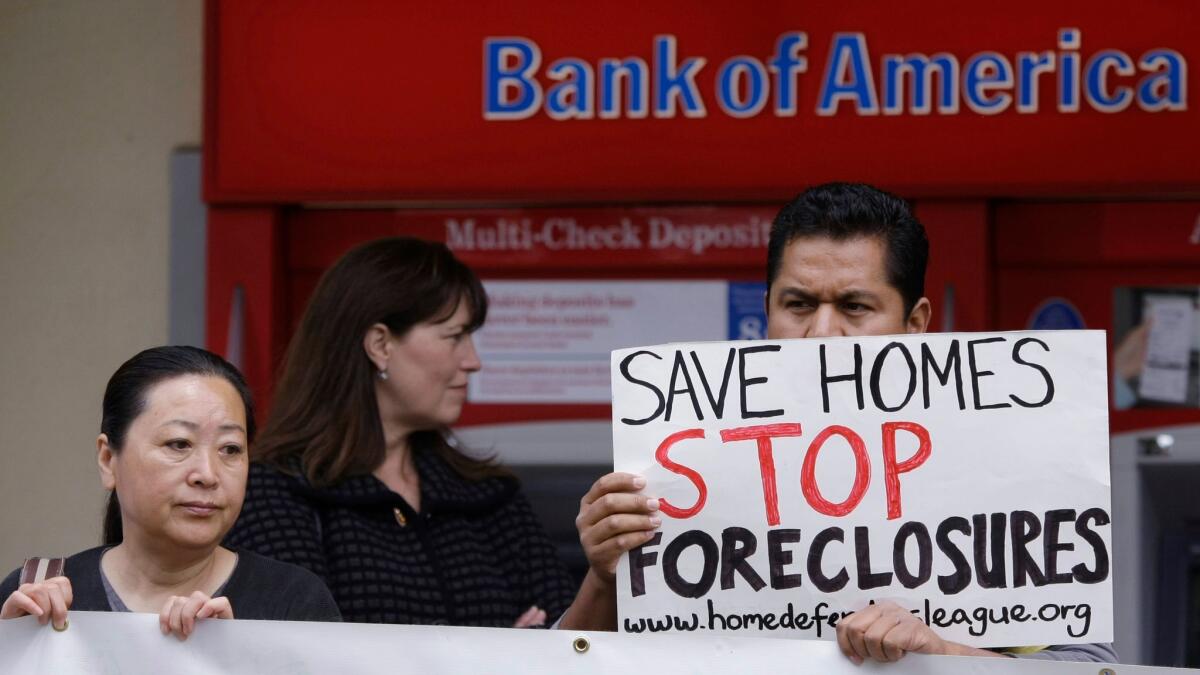Taxpayers are still bailing out Wall Street, eight years later

Eight years after taxpayers rescued the U.S. financial system, some of the country’s largest banks, including JPMorgan Chase & Co. and Wells Fargo & Co., continue to receive billions of dollars in bailout money, according to government data.
Wells Fargo is eligible for up to $1.5 billion in bailout funds over the next seven years. JPMorgan and Bank of America Corp. could receive $1.1 billion and $964 million, respectively.
The continuous flow of funds is a remnant of the $700-billion bailout effort, known as the Troubled Asset Relief Program, put in place during the financial crisis.
About $28 billion of that money was carved out to help distressed homeowners by paying banks to lower their interest rates and monthly payments.
That program, the Home Affordable Modification Program, has undergone several revamps over the last few years and fallen short of the 3 million to 4 million homeowners the Obama administration initially hoped to help. But it continues to operate — it will accept its last homeowner application at the end of this year — and big banks continue to be paid for helping.
The stream of cash for the big banks is worrisome to the Office of the Special Inspector General for the Troubled Asset Relief Program, or SIGTARP, the chief watchdog of the financial crisis-era bailouts. Many of the banks have repeatedly broken the rules of the program, including unfairly kicking out homeowners and making it too difficult to apply for the help.
“Why are we paying for nonperformance? … At what point is somebody is going to say enough is enough?” said Christy Goldsmith Romero, special inspector general with the Troubled Asset Relief Program, who investigates crime at companies that received taxpayer bailout funds.
“If a homeowner doesn’t follow the rules in [the Home Affordable Modification Program], they get knocked out of the program. If a bank doesn’t follow, they still get paid by Treasury.”
The banks and the Treasury Department, which oversees the homes program, defend it. The “error rates” have fallen significantly, Mark McArdle, deputy assistant secretary for financial stability, said in a statement.
The SIGTARP report is “inaccurate,” Wells Fargo said. “We respond quickly to correct any errors we identify or that are brought to our attention.”
Bank of America said it has helped more than 2.1 million customers avoid foreclosure through the homes program and others. “These initiatives continue to help those who face financial difficulty today, even as the economy has recovered overall,” the bank said.
JPMorgan, which has more than $2 trillion in assets, said most of the money it receives through the program is passed along to investors and homeowners who receive incentives for paying their mortgages on time.
The biggest beneficiary of the housing program, by far, is Ocwen Financial Corp. The Atlanta company services millions of mortgages for investors, including collecting payments from homeowners. It has already received $2.9 billion from the homes program, and over the next seven years it could receive an additional $2.6 billion.
“We are extremely proud of our performance and our success in helping struggling borrowers remain in their homes,” Ocwen said.
Merle writes for the Washington Post.
ALSO
The financial world is betting Clinton will win. What if it’s wrong?
Here’s why pot growers are paying millions for old greenhouses
Stores hustle to get their holiday goods as fallout from the Hanjin shipping mess continues






